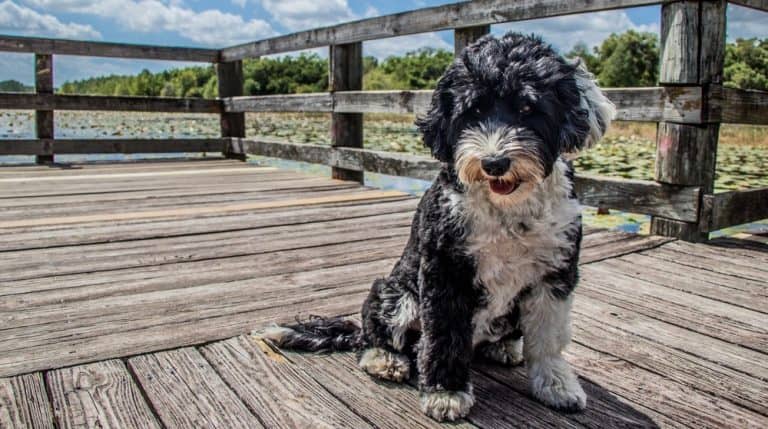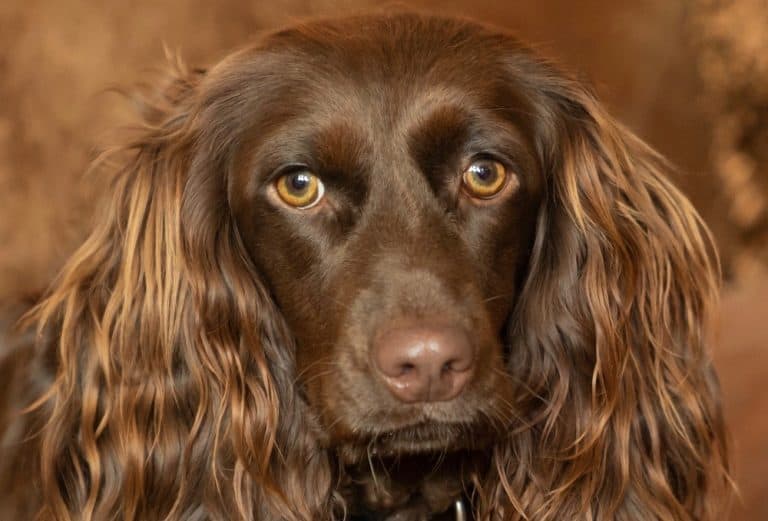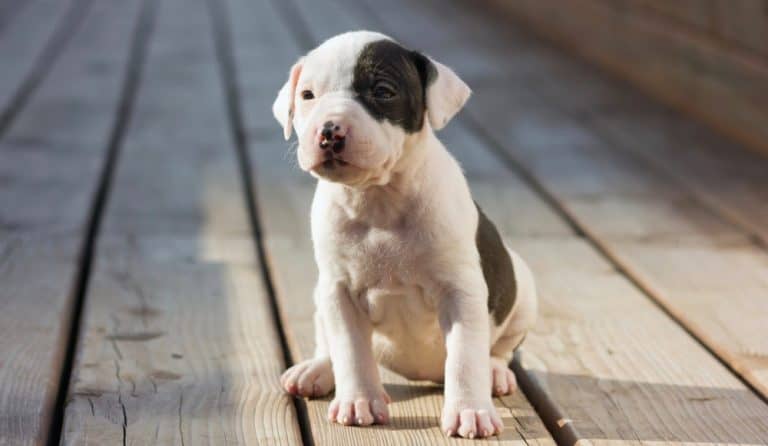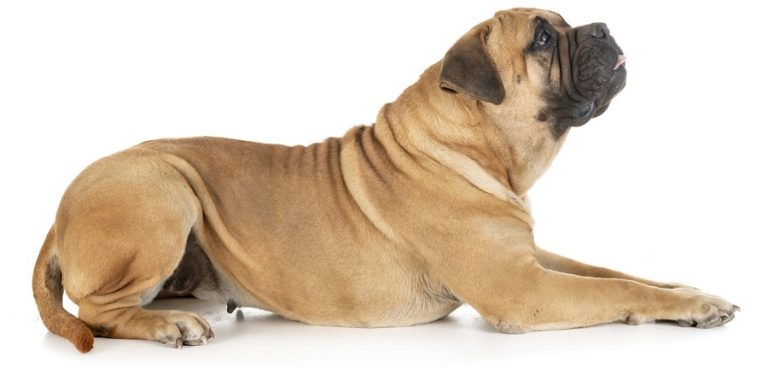Basset Hound Weight Chart – Size & Growth Chart
Known for their long ears, sad eyes, and droopy appearance, you might be able to assume that you know how big your Basset Hound will get.
But, unless you have experience with them, you should consult with a Basset Hound weight chart to know exactly what you are getting into.
We have all of the answers to the questions that you might have about a growing Basset Hound puppy, from how big you can expect your pup to get to all of the factors that can affect the adult size of your puppy. Here is what you should know.
When Is A Basset Hound Fully Grown?

Like most dogs, a Basset Hound is considered fully grown when he is about a year old.
But, even at a year old, your Basset Hound might still have some growing yet to do. Most Basset Hounds do not reach their final adult size until they are 16 months old.
Even if your Basset Hound has reached his final height by the time that he is 16 months, most dogs will continue to gain weight until they are about 2 years old.
Since this is a stockier breed, you shouldn’t be surprised to see your pup pack on some extra pounds.
Basset Hound Weight Chart
One of the best methods that you can use to determine what your Basset Hound’s final size will be is to consult with a Basset Hound Weight Chart.
A weight chart uses estimates to help you work out how big your Basset Hound puppy will be when he is fully grown.
Weight charts can also be used to help you know where your dog is as far as averages go and will help you know whether your dog has been growing consistently.
In order to use the Basset Hound growth chart, you should start with the age that your puppy is now and see where your puppy is based on the averages for his sex and age.
For example, if you have a 4 month old female Basset Hound puppy, you can use the weight chart to know that the average for that age is between 23 and 28 pounds.
If your dog is between those numbers, then your dog is average. If your dog is under or over, you can find that out then too.
Now you can look forward along your dog’s growth curve to get an idea of what his final size will be based on his current size.
Basset Hound Puppy Weight Chart
| Age | Male Weight | Female Weight |
|---|---|---|
| 3 Months | 19 - 24 lbs | 17 - 22 lbs |
| 4 Months | 26 - 30 lbs | 23 - 28 lbs |
| 5 Months | 30 - 37 lbs | 28 - 35 lbs |
| 6 Months | 36 - 45 lbs | 32 - 41 lbs |
| 7 Months | 39 - 48 lbs | 35 - 46 lbs |
| 8 Months | 44 - 55 lbs | 37 - 53 lbs |
| 9 Months | 46 - 57 lbs | 39 -54 lbs |
| 10 Months | 47 - 58 lbs | 41 - 55 lbs |
| 11 Months | 49 - 61 lbs | 45 - 57 lbs |
| 12 Months | 52 - 63 lbs | 46 - 58 lbs |
Basset Hound Growth Chart – What To Expect
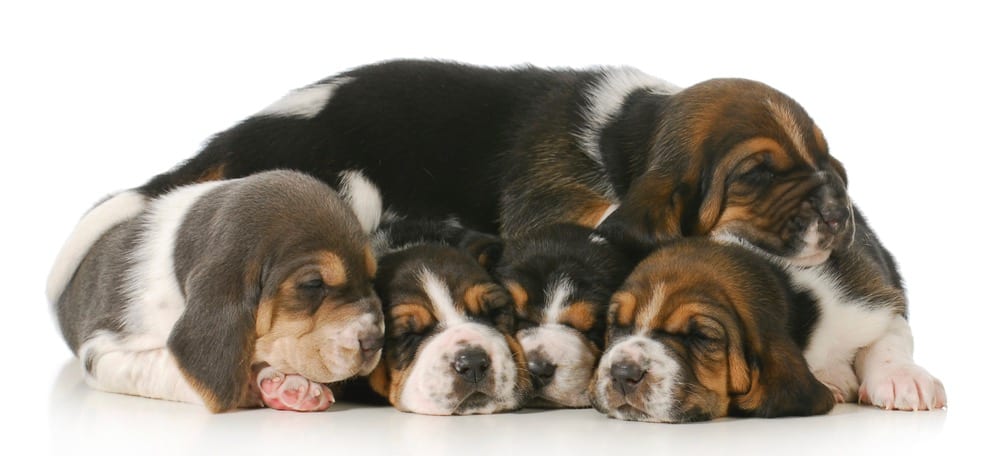
Birth – 2 Weeks
The first two weeks of your puppy’s life is referred to as the neonatal stage. The puppies will only weight a few ounces when they are born, but should easily gain a pound within the first 2 weeks.
The puppies’ eyes will be closed and they will not leave their mother at all during this period. They will also be completely reliant on their mother for milk. If it is a large litter, make sure all the puppies are growing.
3 Weeks – 12 Weeks
Between 3 weeks and 12 weeks, your puppy will go through several different growth spurts. It is a huge growth period. By the time that your puppy is 12 weeks old, he will weigh anywhere from 17 to 24 pounds and be eating puppy food only.
His energy level will also go up quite a bit during this period and he will no longer be with his mother or his littermates.
4 Months – 9 Months
When your Basset Hound puppy is 4 months old, you can expect him to weigh around 23 to 30 pounds, depending on the sex of your dog and his genetics.
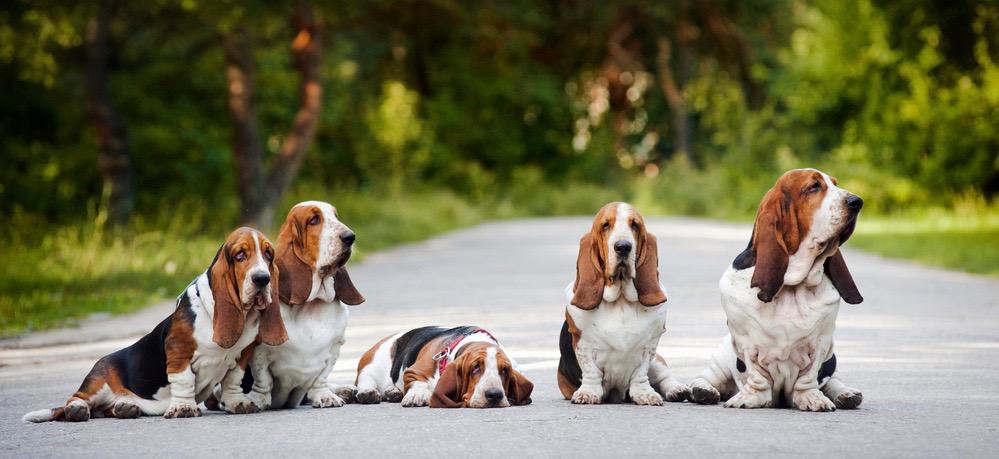
Since the bulk of his growth will happen by 9 months, it should come as no surprise that your dog will weigh between 39 and 57 pounds by 9 months old. He still has some growing to do, but the rate will slow down.
10 Months – 18 Month
A Basset Hound puppy will still be growing between 10 and 16 months, but the rate of growth will have slowed down quite a bit as the puppy inches toward his final, adult weight.
At 10 months old, the average weight of a Basset Hound is between 41 and 58 pounds. At 16 months, the range is between 48 and 64 pounds. You should keep feeding your dog puppy food until he is at least a year old.
Adult
As we mentioned above, your Basset Hound will likely stop growing by 16 months, but he may continue to gain weight up to 24 months.
The average range for an adult Basset Hound is between 40 and 65 pounds, depending on the dog. They are not very tall in comparison to their weight, however.
The average height of a Basset Hound is between 11 and 15 inches, with an average body length between 26 and 35 inches.
How Big Do Basset Hounds Get?
If you have been looking at the weight chart for your Basset Hound and trying to work out whether your estimates are right, there are some other ways that you can get an idea of what to expect.
If you are able to look at the dog’s parents for some guidance, which is a big indicator, since your dog will likely be the same size as his parents.
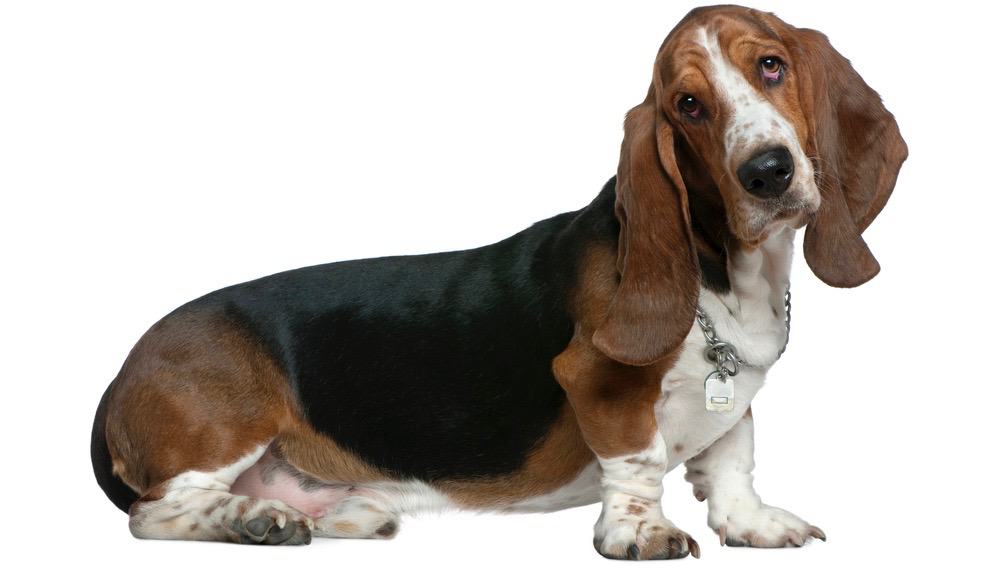
Dogs typically have to grow into their paws as well, so that can be another way to tell whether your dog will get much bigger.
There are also some DNA tests out there that can give you a better insight into the genetic history of your dog.
Will Neutering/Spaying My Basset Hound Affect His Growth?
The traditional rule of thumb when it comes to spaying or neutering your Basset Hound is to wait until your dog is 6 months old and then have it done.
Having your dog spayed or neutered will help prevent unwanted pregnancies and can help with other health conditions, so if your dog isn’t used for breeding, it is the way to go.
In more recent years, it has come more recommended to wait until the dog has finished growing before having him spayed or neutered.
Early sterilization will not stunt your dog’s growth, but it might put their joints in jeopardy in the future. Ask your vet when she recommends that you have your dog fixed.
Basset Hound Size Chart
If you are wondering about the average height of a Basset Hound, we are here to help. On average, a Basset Hound will grow to between 11 and 15 inches in height. They have shorter legs and will never be tall.
To measure your Basset Hound’s height, you need to have him stand on all four paws and then measure from the highest point on his back, usually the shoulder blades, down to the ground.
In general, females are shorter than males, but the breed is short all around, so you likely won’t be able to detect a difference.
Bloodhound vs Basset Hound Size
While both Basset Hounds and Bloodhounds are both types of hound dogs, they do not share all of the same traits. In general, Basset Hounds are smaller than Bloodhounds.
Bloodhounds have some similar appearances and traits, but where a Basset Hound stands between 11 and 15 inches, a Bloodhound stands between 23 and 27 inches. Even the biggest Basset Hounds cannot be mistaken for a Bloodhound.
Weight-wise, a Bloodhound can reach up to 110 pounds. They are large breed dogs and will live shorter lives than Basset Hounds. The maximum weight for a Basset Hound is 65 pounds.
Factors That Affect Basset Hound Growth
Genetics & Gender
The biggest factors that affect the size of your Basset Hound is going to be genetics and gender. If your Basset Hound comes from a long line of tall Basset Hounds, your dog likely will be tall.
Most males are taller than females as well, so that is also a big factor that will determine your dog’s size, though the difference between male and female Basset Hounds is pretty small.
Nutrition
Nutrition is so essential for growing puppies. The way that they are fed when they are still developing can definitely affect the outcome of their health when they get larger.
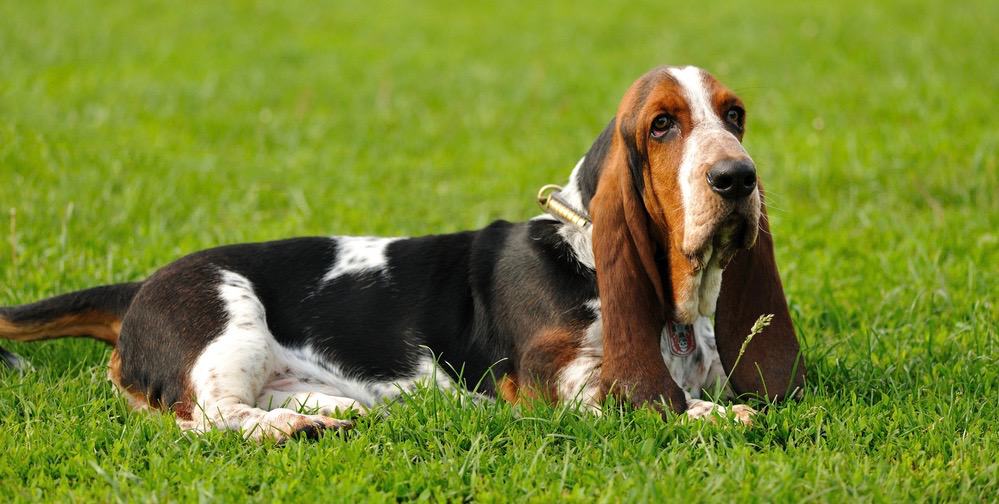
Nutrition will not stunt their growth, but it can affect the strength of their bones, their eyesight, and other parts of their bodies which will show up later in life. Make sure that your puppy is eating a balanced diet and that you are giving him quality food.
Physical Activity & Health
Your dog’s physical activity and health can also have an impact on his growth. Keeping your dog active and fit from a young age will set him up for a long life of health right out of the gate.
Since Basset Hounds have a tendency to be stocky and heavy, getting an overweight Basset Hound to lose weight is really difficult. Instead, keep him active and healthy throughout his puppyhood so he stays healthy in adulthood.
What If My Basset Hound Is Not The Right Weight
A common concern among all pet owners is what to do if your dog is not the right weight.
If you have consulted the weight chart and found that your dog is not on his growth curve or your vet has told you to help him lose or gain weight, we can help you out.
In order to help a Basset Hound slim down a little bit, the easiest things to do is exercise and diet, just like it is with humans.
You should make sure that your dog is walking and playing all of the time. Since the breed likes to be lazy, you need to keep him active from the beginning.
You should also make sure that your dog is eating healthy foods. Look at the ingredients of your dog’s food and the amount that you are feeding him to make sure it lines up. Your vet should be able to guide you here.
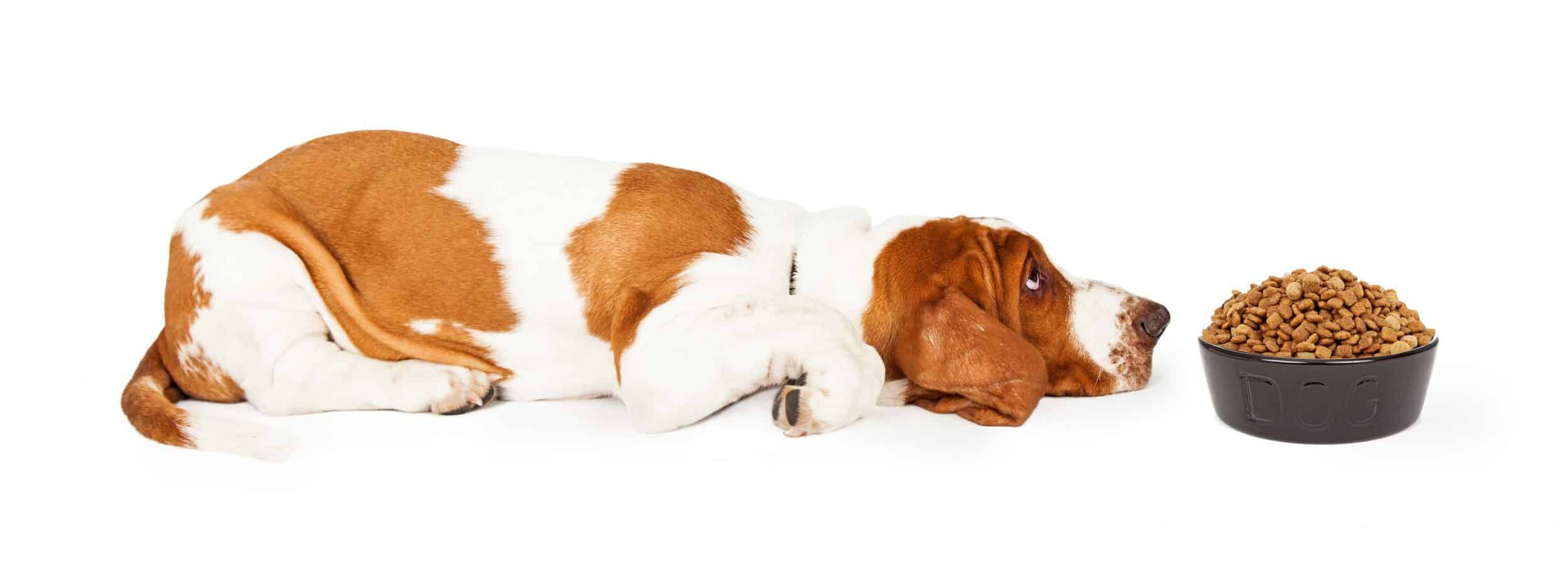
How Much Does It Cost To Own A Basset Hound?
If you are buying a purebred Basset Hound puppy, you can expect to pay between $450 and $1,500. The average cost of a Basset Hound puppy is $800.
The price depends on where you get the dog and his genetic lineage, generally.
In the first year, you can expect to pay around $2,500, with all of the first-year expenses, like spaying or neutering, microchipping, and vaccines.
After the first year, you can expect to pay about $1,500 a year for vet visits, food, and any other things that might come up. On average, a Basset Hound will cost you $20,000 during his lifetime.
Basset Hound Genetics And Common Health Problems
Unfortunately, Basset Hounds are prone to certain genetic ailments, as is the case with all purebred dogs.
The common conditions that occur in Basset Hounds are panosteitis, hip dysplasia, skin disease, glaucoma, and lower eyelid droop.
Panosteitis is a condition that can afflict a Basset Hound as he is growing, also referred to as growing pains.
It is when the outside of the leg bones becomes inflamed, causing temporary lameness and severe pain. There is no treatment or cure, but it should go away after the dog is done growing.
Hip dysplasia happens when the joints of the dog’s hip bones have not grown correctly. It will cause mobility issues as your dog gets older. Your vet can give you some treatments for it, but there is no cure.
The eye conditions are usually treatable with corrective surgery and skin conditions can be dealt with as well.
Final Words
Basset Hounds are a wonderful dog breed to own. Anyone can easily fall in love with their sweet, droopy expressions and loving personality.
But before you decide to adopt a Basset Hound, you need to know what to expect as far as the dog’s size goes.
It is important to know that they are not large dogs and will need to be given the best quality of food and a good amount of exercise to ensure that they live long, happy lives.
You can always consult with a Basset Hound size chart to see where your dog is on averages and to keep track of his growth.

